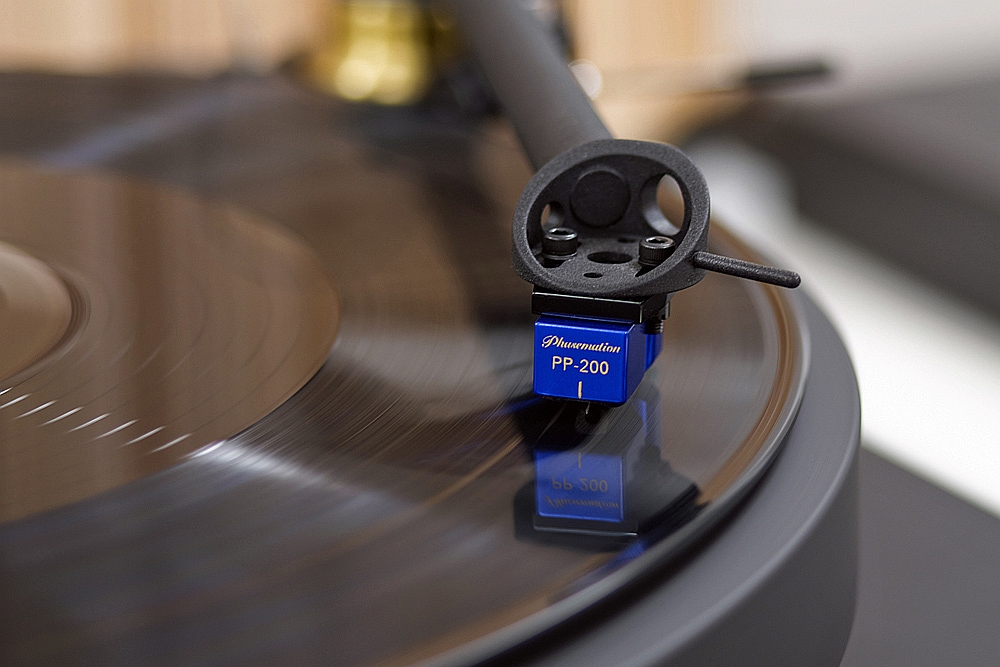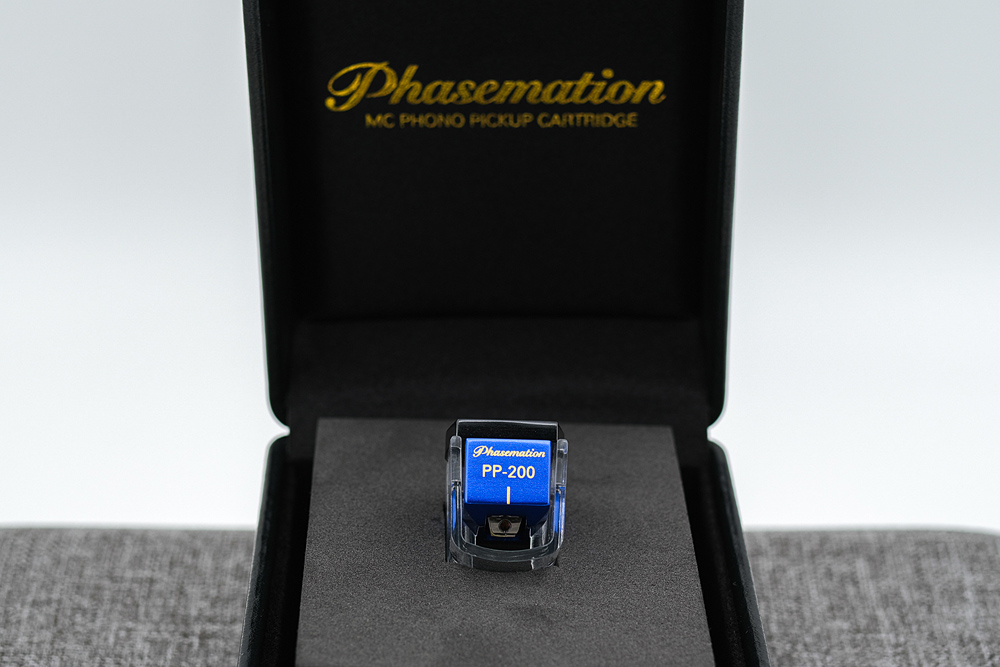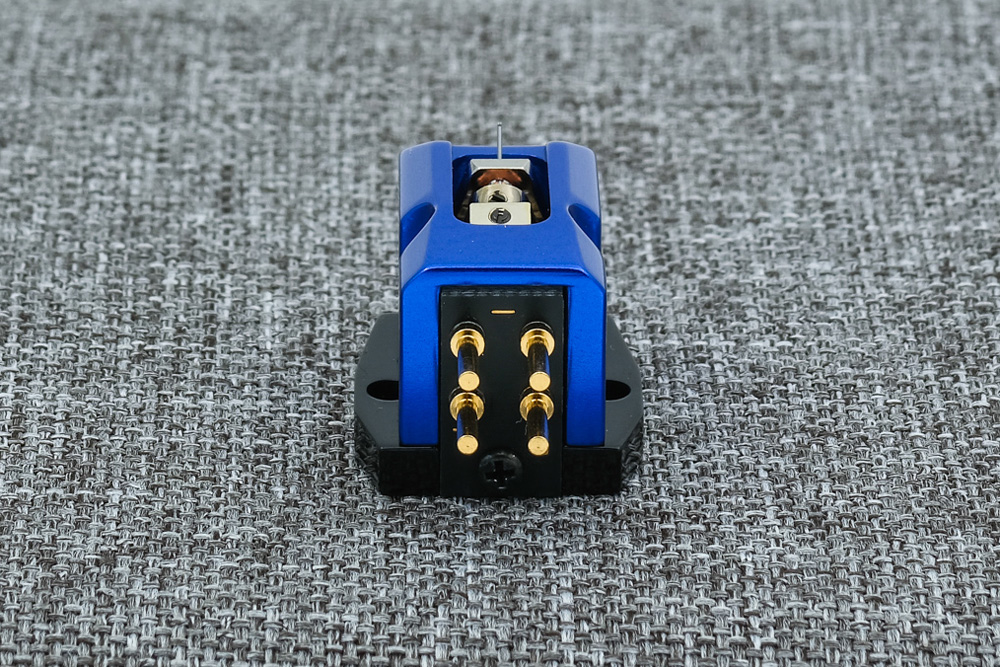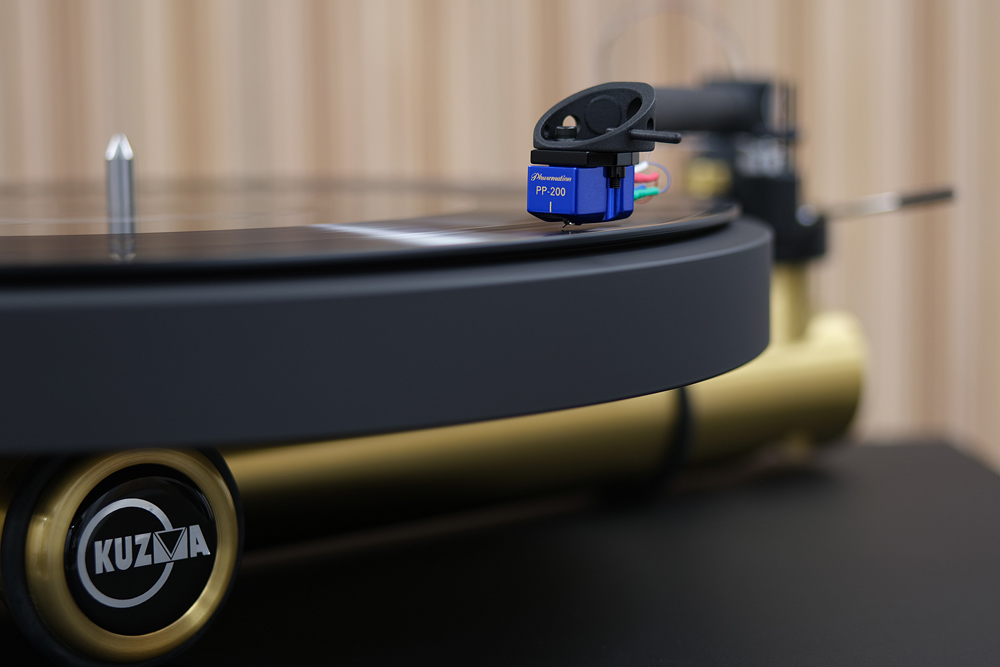Japanese high end company Phasemation relatively-recently released its “basic” PP-200 Moving Coil cartridge. Sporting a lovely deep metallic blue colour, this low output MC features trickle down technology from the company's top models including a rigid Duralumin alloy mounting base with an aluminium body, boron cantilever and a fine line stylus. Shipped in an oversized padded black case ensures this mini jewel arrives safely… A major emphasis on 'live' sounding products guides the Phasemation design philosophy.
Phase-Perfect
The origins of Phasemation begin in the early 1970s when Kyodo Denshi Engineering started construction of electronic measuring and test equipment. This type of equipment had to be of a very high standard for measuring purposes and saw the company making OEM Step-Up Transformers for other Hi-Fi brands.
In 2002 Phasemation started selling Hi-Fi under its own brand with the name Phase-Tech. Products included the P-1 low output MC, various phono stages and digital-to-analogue converters. In 2010 the name was changed to Phasemation combining the words Phase and Information. The company's design philosophy is expressed as: “Fundamentals of Hi-Fi audio is to reproduce live music stage by left and right two channels sound. To attain that goal, the phase characteristics between the channels are very important, and that is why we created our brand”.
So to the PP-200 which employs a rigid duralumin and aluminium body for stability and vibration control. A neodymium magnet and 6N oxygen free copper (which means a purity 99.9999%) have been adapted for the generator coils. A pure boron cantilever with a glued fine line diamond-tipped contact stylus does the tracking. Low output of 0.3mV is produced so a SUT or Head-amp is required.
The PP-200’s channel separation is quoted at a respectable -25dB and the cartridge also features a fairly stiff compliance of 8.5 u/mN so a tonearm of medium effective mass is required to allow for accurate groove tracking. The cartridge pins are well-marked for correctly attaching the tonearm wires. The cartridge body-mounting holes are not threaded and the supplied aluminium bolts have round nuts which, from experience, require patience and a deft hand to fit.
Frequency is quoted as 10 Hz to 30 kHz so an extended bandwidth Hi-Fi system will be needed to experience the wide frequency range! What’s more, time taken to set up the PP-200 meticulously will be well rewarded.
Looking at the front of the PP-200 cartridge, the blue body has the bottom cut back at 45 degrees to allow for easier viewing of the cantilever/stylus for cueing and cleaning.
Before I go onto describing the sound of the Phasemation PP-200 it would be best to reflect a little on the above descriptions and detail what they mean in regards to setting up a good cartridge to sound its best. Let's start with the stylus shape: a fine line contact. As the name of the stylus shape suggests, the contact area that follows the record walls is a 'fine line' approximately 1.5um by 9um or 0.001mm by 0.009mm. That's a very small contact area and, unless the stylus is setup correctly, the sound quality will suffer!
So before installing a cartridge, I view the stylus through an appropriate microscope to determine how in line or parallel it is to the cantilever. This is known as the stylus zenith. Next view is from the front to view how perpendicular the stylus is in relation to the cartridge body. This is known as stylus azimuth and the channel separation figures relate to this. Then to the side view, to help with determining the stylus rake angle (SRA) and the related vertical tracking angle (VTA).
So, on viewing the PP-200 I found the stylus zenith was out by 1/4 of a degree and the azimuth was two degrees to the right. SRA was accurate. As a note, manufacturers of cartridges can have up to four degrees allowance for positioning of the stylus; that's a lot!
Many publications still advise to install cartridges using alignment of the body parallel to the cartridge protractor. That's OK if the stylus is aligned correctly with the cantilever and the cantilever aligned with the body. The best way to align is with the stylus only.
So, this being a fairly stiff suspension, I installed the cartridge on the venerable SME V arm which is a medium effective-mass arm. I was able to use some long nylon cartridge screws and a pivot between the arm and cartridge to allow for azimuth adjustment.
Figures obtained from the AnalogMagik alignment software were: Channel separation of -29dB in both left and right (better/quieter than the -25dB specified). It’s very important to get the best figure as this will render vocalists and instruments with greater detail and separation.
Cartridge/tonearm resonance of 12 Hz was achieved (between 8 Hz and 12 Hz is good). The stated impedance for the Phasemation PP-200 is 4 ohms so I set my Music First Audio step up transformer to 400 ohms. So with the cartridge fitted and aligned properly in the SME V fitted to a Garrard 401 turntable, it was time for the listening to begin…
Phasemation Emotion in Motion
First up was Bob Marley & The Wailers’ Rastaman Vibration. First impressions of the PP-200 was the clear and expressive midrange. On the title track, Marley’s vocals were centre-placed, clear and easy to follow. The I Threes’ gorgeous backing vocals on the left and the Barrett brothers giving deft touches on the conga drums and triangle on the left. I felt already that the PP-200 was rewarding me with a taste of high-end sound without the associated cost.
Crazy Baldheads provided fun in recognising the different percussive sounds from a slide whistle, wooden blocks to the grating of a Gūiro. I found the midrange to be most expressive with the bass a little shy and the treble region non fatiguing, definitely a good thing when using the Yamaha NS1000 monitors!
In-keeping with my enjoyment of the PP-200's midrange I turned my listening to one of my favourite modern singer/song writers Jenny Lewis. Her fourth solo album On the Line was released in 2019 after the breakup with her long-term partner Jonathan Rice and sees Jenny Lewis continue to combine autobiographical and fantasy elements into her rich songs.
The track “Dogwood” starts with ambient studio noise which the PP-200 allowed me to hear and get a sense of the recording space. Jenny's singing and simple piano arrangement begin before being enveloped with guitar and drums, then rolling back to the piano and vocals. A very deep heavy bass line completes the track which the Phasemation cartridge had no problem conveying and detailing. Very impressive stuff!
"I met the Devil in Austin..." starts the song “Party Clown” and continues Lewis's fantasy song writing style throwing instruments into this multi layered track, including Tubular bells whose sound and dynamic presence was accurately rendered. There is a lot going on in this track and the Phasemation managed to convey it across with ease. There was no masking or blurring of leading edges of the Tubular Bells and the other instruments.
For something a little different, I placed a slightly worn copy of Miles Davis and Marcus Miller’s Siesta on the turntable. Well, I am pleased to inform you that the Phasemation cartridge does not draw undue attention to the scuffs and marks on this stunningly recorded album. The opening track “Lost in Madrid Part 1” begins with haunting synths and percussive sounds before Miles Davis’ trumpet soars above the softly roaring synthesiser. Very atmospheric.
The title track starts with a Spanish guitar on the left which was rendered most accurately and the Castanets sounded real and suitably snappy! The trumpet, synthesiser and drums played against each other in a holistic swirl. This cartridge revels in this well recorded album from 1987.
Then to some classical, namely Elgar's Pomp and Circumstance on the HMV Classics Label 45 rpm Dynamic Sound Series. “Land of Hope and Glory № 1” and also № 4 start with great gusto of stirring violins and punchy brass underpinned by timpani drums and crashing cymbals. To get the best from classical music records the cartridge must be able to accurately portray the instruments’ tone as well as the dynamics and subtle micro details and here the Phasemation PP-200 is doing a sterling job with this famous March.
The flip side of this EP has the famous “Dam Busters March” which begins with violins playing to a quick crescendo before settling into the main melody. The violins sound correctly light in tone, not etched. Brass instruments are strong without sounding bright. The PP-200 handles this busy March without by-passing any of the musical information. Timpani are faithfully rendered with power and plenty of bass wallop. Great stuff. Now where is my uniform?
Conclusion
So there we have it. The PP-200 is a cartridge which some will find ticks enough high-end sound requirements that they will need to look no further. Perhaps not even up the Phasemation cartridge line, who knows. Accuracy, detail, dynamics. A glorious mid-band and wide imaging. This little blue cartridge does it all. Its extremely good presentation of the mid-band, particularly female vocals will have you diving into your record collection with gusto.
The PP-200 cartridge is in a "Goldilocks" place, in that it would suit as an upgrade in a mid-range player and would certainly not be embarrassed by being placed in a high-end turntable. Yes, it's that accomplished!
Providing you give the Phasemation PP-200 a helping hand in setting it up correctly, then it will reward with a healthy dose of realism and the taste of high-end! Well recommended.
… Mark Busby
www.soundstageaustralia.com
Associated Equipment
- Speakers – Yamaha NS-1000M, custom 18-inch subwoofer
- Preamplifier – PS Audio BHK, Music First Audio step up transformer, EMIA two-box tube phono stage
- Amplifier – Musical Fidelity Tri-Vista 300, Leak Stereo 60, restored Leak Stereo 20
- Sources – Analogue: Garrard 410 and SME V arm, Thorens TD 124 Mk1 with Woodsong bearing, Technics SP10 Mk3, SME 3012 silver wired tonearm, Fidelity Research FR-64S, Music Maker 3 moving iron & DS Audio DS-E1 optical cartridges, Tube Sound Audio phono stage, Sansui TU-717 tuner. Digital: Marantz CD-94 MkII, Musical Fidelity A5 CD players,
- Cables – Revelation Audio Labs solid silver and Vertere
Phasemation PP-200 Moving Coil Cartridge
Price: AU$1499
Australian Warranty: TBA
Australian Distributor: Pure Music Group
+61 409 504 805
www.puremusicgroup.com
Phasemation
8-40-17 Shinyoshidahigashi, Kohoku-ku
Yokohama-shi, Kanagawa 223-0058
Japan
+81 45 710 0975
www.phasemation.com
















